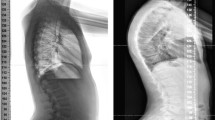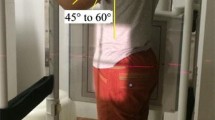Abstract
Purpose
Sagittal spine and pelvic alignment of adolescent idiopathic scoliosis (AIS) is poorly described in the literature. It generally reports the sagittal alignment with regard to the type of curve and never correlated to the thoracic kyphosis. The objective of this study is to investigate the relationship between thoracic kyphosis, lumbar lordosis and sagittal pelvic parameters in thoracic AIS.
Methods
Spinal and pelvic sagittal parameters were evaluated on lateral radiographs of 86 patients with thoracic AIS; patients were separated into hypokyphosis group (n = 42) and normokyphosis group (n = 44). Results were statistically analyzed. The lumbar lordosis was lower in the hypokyphosis group, due to the low proximal lordosis. The thoracic kyphosis was not correlated with any pelvic parameters but with the proximal lordosis. The pelvic incidence was correlated with sacral slope, pelvic tilt, lumbar lordosis and highly correlated with distal lumbar lordosis in the two groups. There was a significant linear regression between thoracic kyphosis and proximal lordosis and between pelvic incidence and distal lordosis.
Conclusions
We can consider that the proximal part of the lordosis depends on the thoracic kyphosis and the distal part depends on the pelvic incidence. The hypokyphosis in AIS is independent of the pelvic parameters and could be described as a structural parameter, characteristic of the scoliotic deformity.



Similar content being viewed by others
References
Schwab F, Lafage V, Patel A et al (2009) Sagittal plane considerations and the pelvis in the adult patient. Spine 34:1828–1833
Duval-Beaupère G, Schmidt C, Cosson P (1992) Abarycentremetric study of the sagittal shape of spine and pelvis: the conditions required for an economic standing position. Ann Biomed Eng 20:451–462
Legaye J, Hecquet J, Marty C et al (1993) Sagittal equilibration of the spine: relationship between pelvis and sagittal spinal curves in the standing position (in French). Rachis 5:215–226
Mangione P, Sénégas J (1997) Normal and pathologic sagittal balance of the spine and pelvis (in French). Rev Chir Orthop 83:22–32
Legaye J, Duval-Beaupère G, Hecquet J et al (1998) Pelvic incidence: a fundamental pelvic parameter for three dimensional regulation of spinal sagittal curves. Eur Spine J 7:99–103
Marty C, Boisbaubert B, Descamps H et al (2002) The sagittal anatomy of the sacrum among young adults, infants and spondylolisthesis patients. Eur Spine J 11:119–125
Rajnics P, Templier A, Skalli W et al (2002) The association of sagittal spinal and pelvic parameters in asymptomatic persons and patients with isthmic spondylolisthesis. J Spinal Disord 15:24–30
Roussouly P, Berthonnaud E, Dimmet J (2003) Geometrical and mechanical analysis of lumbar lordosis in an asymptomatic population: proposed classification (in French). Rev Chir Orthop 89:632–639
Boulay C, Tardieu C, Hecquet J et al (2006) Sagittal alignment of spine and pelvis regulated by pelvic incidence: standard values and prediction of lordosis. Eur Spine J 15:415–422
Gelb DE, Lenke LG, Bridwell KH et al (1995) An analysis of sagittal alignment in 100 asymptomatic middle and older aged volunteers. Spine 20:1351–1358
Jackson RP, Peterson MD, MacMamus AC et al (1998) Compensatory spinopelvic balance over the hip axis and better reliability in measuring lordosis to the pelvic radius on standing lateral radiographs of adult volunteers and patients. Spine 23:1750–1767
Vaz G, Roussouly P, Berthonaud E et al (2002) Sagittal morphology and equilibrium of pelvis and spine. Eur Spine J 11:80–87
Kobayashi T, Atsuta Y, Matsuno T et al (2004) A longitudinal study of congruent sagittal spinal alignment in an adult cohort. Spine 29:671–676
Öhlen G, Aaro S, Bylund P (1988) The sagittal configuration and mobility of the spine in idiopathic scoliosis. Spine 13:413–416
Raso VJ, Russell GC, Hill DL et al (1991) Thoracic lordosis in idiopathic scoliosis. J Pediatr Orthop 11:599–602
Mac-Thiong JM, Labelle H, Charlebois M et al (2003) Sagittal plans analysis of the spine and pelvis in adolescent idiopathic scoliosis according to the coronal curve type. Spine 28:1404–1409
Upasani V, Tis J, Bastrom T et al (2007) Analysis of sagittal alignment in thoracic and thoracolumbar curves in adolescent idiopathic scoliosis. How do these two curve types differ. Spine 32:1355–1359
Lonner BS, Auerbach JD, Sponseller P et al (2010) Variations in pelvic and other sagittal parameters as a function of race in adolescent idiopathic scoliosis. Spine 35:E374–E377
Hanson DS, Bridwell KH, Rhee JM et al (2002) Correlation of pelvic incidence with low-grade and high-grade isthmic spondylolisthesis. Spine 27:2026–2029
Mac-Thiong JM, Berthonaud E, Dinar JR et al (2004) Sagittal alignment of the spine and pelvis during growth. Spine 29:1642–1647
Mac-Thiong JM, Labelle H, Berthonnaud E et al (2007) Sagittalspinopelvic balance in normal children and adolescents. Eur Spine J 16:227–234
Mendoza-Lattes S, Ries Z, Gao Y et al (2010) Natural history of spinoplevic alignment differs from symptomatic deformity of the spine. Spine 35:E792–E798
Yong Q, Zhen L, Zezhang Z et al (2012) Comparison of sagittal spinopelvic alignment in Chinese adolescents with and without idiopathic thoracic scoliosis. Spine 37:E714–E720
Roussouly P, Labelle H, Rouissi J et al (2013) Pre- and post-operative sagittal balance in idiopathic scoliosis: a comparison over the ages of two cohorts of 132 adolescents and 52 adults. Eur Spine J 22(suppl 2):S203–S215
Conflict of interest
None.
Author information
Authors and Affiliations
Corresponding author
Rights and permissions
About this article
Cite this article
Clément, JL., Geoffray, A., Yagoubi, F. et al. Relationship between thoracic hypokyphosis, lumbar lordosis and sagittal pelvic parameters in adolescent idiopathic scoliosis. Eur Spine J 22, 2414–2420 (2013). https://doi.org/10.1007/s00586-013-2852-z
Received:
Revised:
Accepted:
Published:
Issue Date:
DOI: https://doi.org/10.1007/s00586-013-2852-z




